Travelling through Nagarhole National park at low speed is such a pleasure and the hope to find the orange striped Monster is thrilling.
The park is a part of the Nilgiri Biosphere Reserve and belongs to the Western Ghats. The forest have main trees of Rosewood, Teak, Sandalwood and Silver oak thus making it a dry deciduous forest.
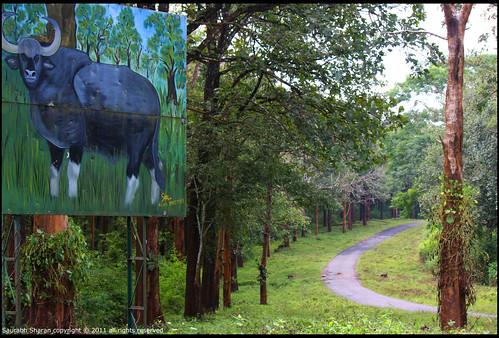
We encounter this huge trunk while driving through the Jungles of Nagarhole.
He was very near to our car (50m) and busy plucking grasses.
He did blow a trumpet when we crossed him and quickly fled away. It was an excited moment...
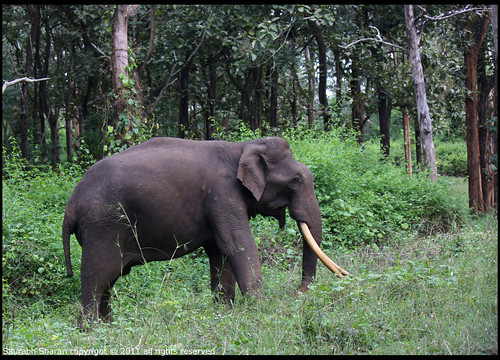
We saw thousands of them hiding in the grass, next to the tar road inside the sanctuary. The chital or cheetal also known as chital deer, spotted deer or axis deer is a deer which commonly inhabits wooded regions of India.
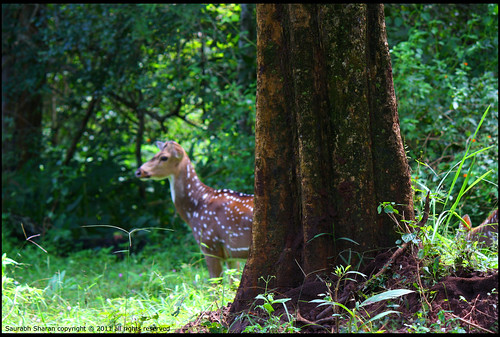
The spotted deer is found in large numbers in dense deciduous or semi-evergreen forests and open grasslands.
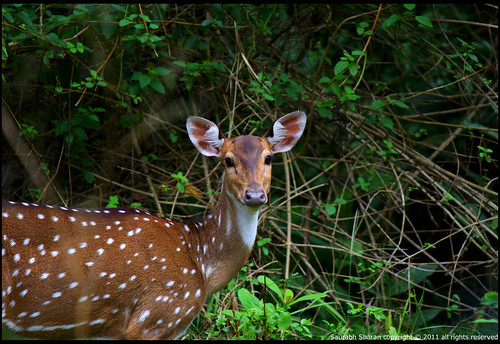
Its very hard to identify the orange glowing tail in the desnse forest, as they hangup very high and are very shy. The Indian giant squirrel rarely leaves the trees, and requires tall profusely branched trees for the construction of nests. It travels from tree to tree with jumps of up to 20 ft. It is a shy, wary animal and not easy to discover. While searching in Nagarhole National park we found this beauty eating leaves, the orange color on the tail was very helpful in identifying an animal up above the trees.
The dark brown, tan and beige (and largest), of the tropical semi-evergreen forests east of the Brahmagiri mountains in Kodagu (Coorg). It is the largest Squirrel of the world.
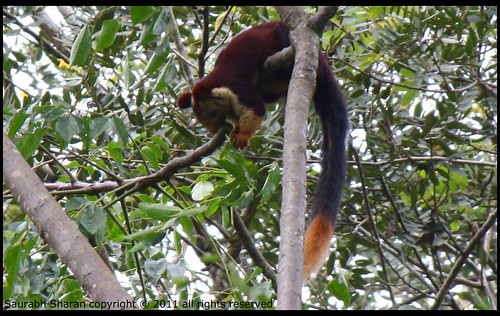
Soon we reached Kuta and we headed for Irrupu Falls, the fall seems three tiered and is located in Brahamagiri forest reserve.Brahmagiri Hills gives a magnificient 3 tier water fall - Iruppu. The trek to the falls is easy and includes steep steps.
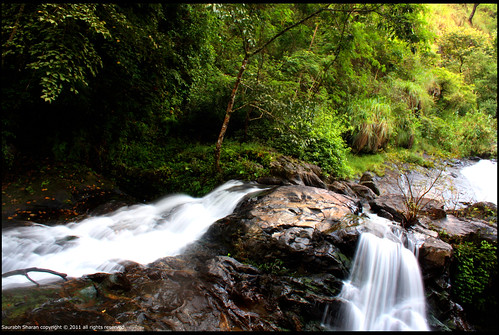
Marmalade hover-fly, is a relatively small hoverfly , widespread throughout all continents.
The upper side of the abdomen is patterned with orange and black bands. Two further identification characters are the presence of secondary black bands on the 3rd and 4th dorsal plates and of faint greyish longitudinal stripes on the thorax. It is among the very few species of flies capable of crushing pollen grains and feeding on them. Taken on the way up to Iruppu falls, Brhamagiri Hills, western Ghats India.

After having a stroll through the Brahamagiri jungles, and a quick bath we tried heading toward Tholpetty National park which is just across the border in Kerala. The park is well guarded and is having more rocky terrian. We hired a four wheel jeep and went inside.
This tree welcomes you to Tholpetty National Park, which is open for Forest Jeeps. The blue sky was blue from the green forest.

Tholpetty National Park next to Nagarhole National Park is good to locate Gaurs. We saw an Herd crossing the jungle road. These were in 8-10 numbers and there was a baby Bison among them.
The gaur (Bos gaurus), also called Indian bison, is a large bovine native to South Asia and Southeast Asia. The species is listed as vulnerable on the IUCN Red List since 1986 as the population decline in parts of the species' range is likely to be well over 70% over the last three generations.
The gaur has a high convex ridge on the forehead between the horns, which bends forward, causing a deep hollow in the profile of the upper part of the head. There is a prominent ridge on the back. The ears are very large; the tail only just reaches the hocks, and in old bulls the hair becomes very thin on the back. In colour, the adult male gaur is dark brown, approaching black in very old individuals; the upper part of the head, from above the eyes to the nape of the neck, is, however, ashy gray, or occasionally dirty white; the muzzle is pale coloured, and the lower part of the legs are pure white or tan.
In India, the population was estimated to be 12,000–22,000 in the mid-1990s. The Western Ghats and their outflanking hills in southern India constitute one of the most extensive extant strongholds of gaur, in particular in the Wynaad – Nagarahole – Mudumalai – Bandipur complex.
The gaur is the largest species of wild cattle, bigger than the African buffalo, the extinct aurochs, and wild water buffalo. The popular energy drink "Red Bull" is made by an Austrian firm under licence from a Thailand company who originally invented and marketed it in Southeast Asia. The original name of the drink in Thai is "Gratin Daang" which means "Red Gaur" (gratin is "gaur" in Thai)

We also spotted several deer, Peacocks and Turtle on the way. There was also abundance of birds chirping around.
This orange spider was very unique in making net inside the leaves.
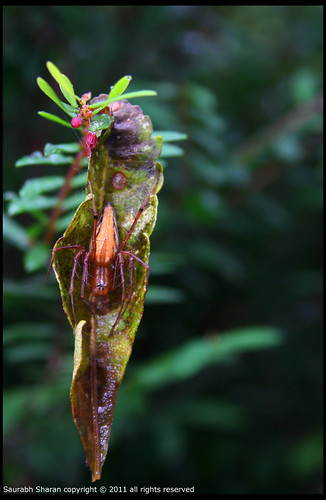
You will also find lots of Langurs around the road.
Gray langurs or Hanuman langurs, the most widespread langurs of India, are a group of Old World monkeys.
Langurs are preyed upon by leopards, dholes and tigers.

Soon we headed towards Kabini forest and went to Balle Elephant camp.While visiting Balle, I saw this elephant dancing after having his daily meal.
There are people who advocate the continued capture of wild elephants even today, because herds isolated by deforestation are coming into conflict with humans.
You can also reach this elephant camp at Balle, you must drive via Karapur from Mysore-Mananthavady Road, via Kabini.
They bathe the elephants in the morning and feed them at around 9 AM then they send them to the wild jungles, to call them back again in evening. I asked the forest departments about this interesting sending to wild, then they replied that these elephants eat a lot and jungle is full of free bamboo shoots.Elephants are classified as megaherbivores and consume up to 150 kg (330 lb) of plant matter per day.
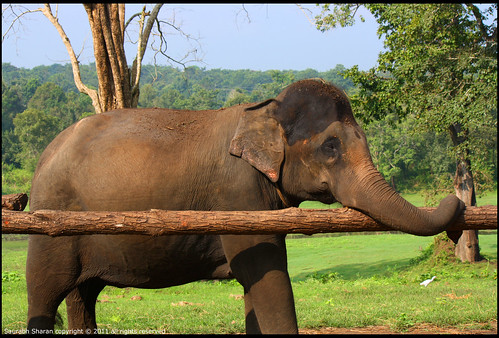
The sight of elephants standing in a row, resting their trunks on wooden poles uncomplainingly and waiting for their turn to get the snack is amusing.
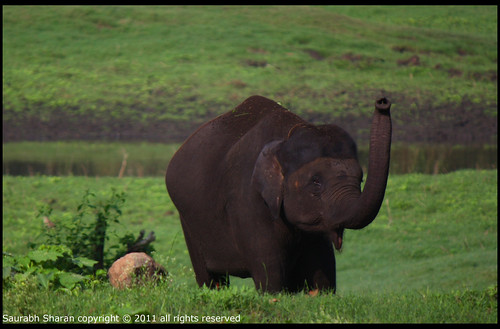
Baby Elephant Dancing on its tune.
The old stockades can still be seen when the river waters recede. Although the custom has been discontinued it is a reminder of the barbaric abuse of the gentle giants.
Baby's day out
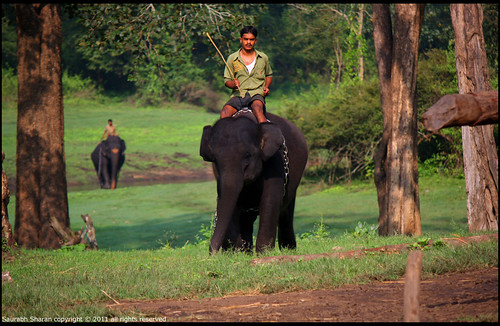
I just gotout from my car (in the pic) and took a shot while the pachyderm was crossing the road.
The old khedda site at Mastigudi and the camp for elephants at Balle. Khedda is an ancient method of capturing wild elephants. In the 19th Century Capt. G.P. Sanderson developed a method using stockades that was particularly effective for the Kabini river surrounds.
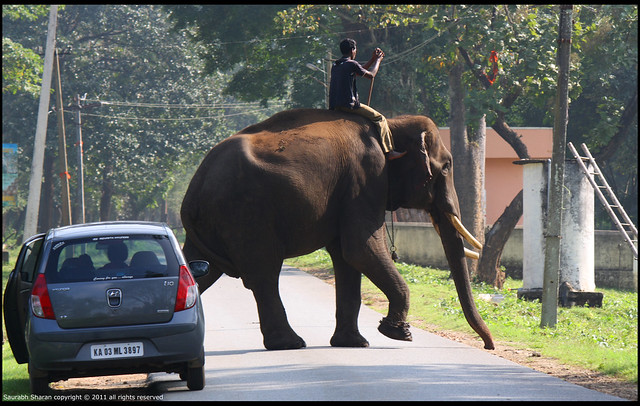
We saw lots of Pond Heron and Cormorants around the Kabini river basin.
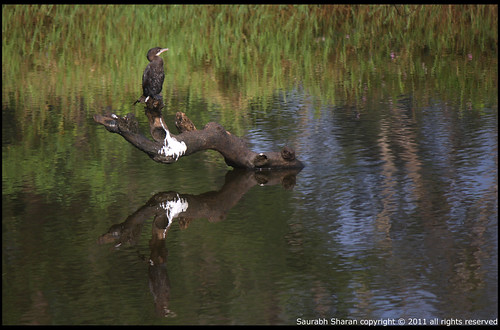
Soon we headed out of the forest and went to Kabini Dam reservoir, which provides water to this amazing kingdom.
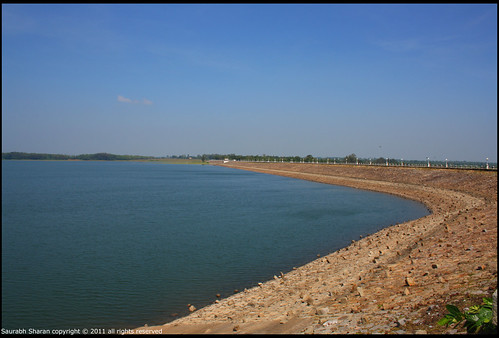
Our day was over and we headed back to Bangalore.
Since its a two day itinerary I suggest you to take a stay either at Kabini/Kuta/Trineveli or Manathvadi.
-Sakshi Jain
and Saurabh
The park is a part of the Nilgiri Biosphere Reserve and belongs to the Western Ghats. The forest have main trees of Rosewood, Teak, Sandalwood and Silver oak thus making it a dry deciduous forest.

We encounter this huge trunk while driving through the Jungles of Nagarhole.
He was very near to our car (50m) and busy plucking grasses.
He did blow a trumpet when we crossed him and quickly fled away. It was an excited moment...

We saw thousands of them hiding in the grass, next to the tar road inside the sanctuary. The chital or cheetal also known as chital deer, spotted deer or axis deer is a deer which commonly inhabits wooded regions of India.

The spotted deer is found in large numbers in dense deciduous or semi-evergreen forests and open grasslands.

Its very hard to identify the orange glowing tail in the desnse forest, as they hangup very high and are very shy. The Indian giant squirrel rarely leaves the trees, and requires tall profusely branched trees for the construction of nests. It travels from tree to tree with jumps of up to 20 ft. It is a shy, wary animal and not easy to discover. While searching in Nagarhole National park we found this beauty eating leaves, the orange color on the tail was very helpful in identifying an animal up above the trees.
The dark brown, tan and beige (and largest), of the tropical semi-evergreen forests east of the Brahmagiri mountains in Kodagu (Coorg). It is the largest Squirrel of the world.

Soon we reached Kuta and we headed for Irrupu Falls, the fall seems three tiered and is located in Brahamagiri forest reserve.Brahmagiri Hills gives a magnificient 3 tier water fall - Iruppu. The trek to the falls is easy and includes steep steps.

Marmalade hover-fly, is a relatively small hoverfly , widespread throughout all continents.
The upper side of the abdomen is patterned with orange and black bands. Two further identification characters are the presence of secondary black bands on the 3rd and 4th dorsal plates and of faint greyish longitudinal stripes on the thorax. It is among the very few species of flies capable of crushing pollen grains and feeding on them. Taken on the way up to Iruppu falls, Brhamagiri Hills, western Ghats India.

After having a stroll through the Brahamagiri jungles, and a quick bath we tried heading toward Tholpetty National park which is just across the border in Kerala. The park is well guarded and is having more rocky terrian. We hired a four wheel jeep and went inside.
This tree welcomes you to Tholpetty National Park, which is open for Forest Jeeps. The blue sky was blue from the green forest.

Tholpetty National Park next to Nagarhole National Park is good to locate Gaurs. We saw an Herd crossing the jungle road. These were in 8-10 numbers and there was a baby Bison among them.
The gaur (Bos gaurus), also called Indian bison, is a large bovine native to South Asia and Southeast Asia. The species is listed as vulnerable on the IUCN Red List since 1986 as the population decline in parts of the species' range is likely to be well over 70% over the last three generations.
The gaur has a high convex ridge on the forehead between the horns, which bends forward, causing a deep hollow in the profile of the upper part of the head. There is a prominent ridge on the back. The ears are very large; the tail only just reaches the hocks, and in old bulls the hair becomes very thin on the back. In colour, the adult male gaur is dark brown, approaching black in very old individuals; the upper part of the head, from above the eyes to the nape of the neck, is, however, ashy gray, or occasionally dirty white; the muzzle is pale coloured, and the lower part of the legs are pure white or tan.
In India, the population was estimated to be 12,000–22,000 in the mid-1990s. The Western Ghats and their outflanking hills in southern India constitute one of the most extensive extant strongholds of gaur, in particular in the Wynaad – Nagarahole – Mudumalai – Bandipur complex.
The gaur is the largest species of wild cattle, bigger than the African buffalo, the extinct aurochs, and wild water buffalo. The popular energy drink "Red Bull" is made by an Austrian firm under licence from a Thailand company who originally invented and marketed it in Southeast Asia. The original name of the drink in Thai is "Gratin Daang" which means "Red Gaur" (gratin is "gaur" in Thai)

We also spotted several deer, Peacocks and Turtle on the way. There was also abundance of birds chirping around.
This orange spider was very unique in making net inside the leaves.

You will also find lots of Langurs around the road.
Gray langurs or Hanuman langurs, the most widespread langurs of India, are a group of Old World monkeys.
Langurs are preyed upon by leopards, dholes and tigers.

Soon we headed towards Kabini forest and went to Balle Elephant camp.While visiting Balle, I saw this elephant dancing after having his daily meal.
There are people who advocate the continued capture of wild elephants even today, because herds isolated by deforestation are coming into conflict with humans.
You can also reach this elephant camp at Balle, you must drive via Karapur from Mysore-Mananthavady Road, via Kabini.
They bathe the elephants in the morning and feed them at around 9 AM then they send them to the wild jungles, to call them back again in evening. I asked the forest departments about this interesting sending to wild, then they replied that these elephants eat a lot and jungle is full of free bamboo shoots.Elephants are classified as megaherbivores and consume up to 150 kg (330 lb) of plant matter per day.

The sight of elephants standing in a row, resting their trunks on wooden poles uncomplainingly and waiting for their turn to get the snack is amusing.

Baby Elephant Dancing on its tune.
The old stockades can still be seen when the river waters recede. Although the custom has been discontinued it is a reminder of the barbaric abuse of the gentle giants.
Baby's day out

I just gotout from my car (in the pic) and took a shot while the pachyderm was crossing the road.
The old khedda site at Mastigudi and the camp for elephants at Balle. Khedda is an ancient method of capturing wild elephants. In the 19th Century Capt. G.P. Sanderson developed a method using stockades that was particularly effective for the Kabini river surrounds.

We saw lots of Pond Heron and Cormorants around the Kabini river basin.

Soon we headed out of the forest and went to Kabini Dam reservoir, which provides water to this amazing kingdom.

Our day was over and we headed back to Bangalore.
Since its a two day itinerary I suggest you to take a stay either at Kabini/Kuta/Trineveli or Manathvadi.
-Sakshi Jain
and Saurabh
2 comments:
Art of story telling. :)
Thanks Gautam
Post a Comment